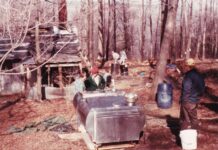COLUMBUS — More Ohio farmers invested extra time and fuel this year to dry their harvested corn and soybeans because both grains were planted several weeks late and had less time to dry in the field.
While drying harvested corn in a mechanical dryer is typical each year, some producers in the state dried soybeans this year for the first time ever.
“Soybeans dry a whole lot better outside when it’s 70 degrees and you can run around in short sleeves. Farmers are harvesting in winter coats,” said Eric Richer, an Ohio State University Extension educator in Fulton County, on the far northwestern border of the state
Hazards of drying
If grain stays in a dryer too long, fires can occur. Also, the longer that corn and soybeans sit in drying units, the greater chance the grains will turn brittle, crack, or break down into dust particles — all of which can decrease the price a grower gets for the grain.
The grain-drying process comes with risks every year, “but they’re worse when you have wetter grain than normal because the grain has to spend more time in the dryer,” said Jason Hartschuh, an OSU Extension educator in Crawford County, just west of Mansfield.
Higher moisture percentages
When Ohio corn is harvested, it typically contains about 20% moisture, but this year some grain has 35% to 40% moisture — nearly double the typical level, Hartschuh said.
Across the state, corn is 90% harvested and soybeans are 95% harvested, according to a U.S. Department of Agriculture report issued Dec. 2.
Both are slightly behind the average harvesting pace over the last five years — corn by 5% and soybeans by 4%. The delay in harvest comes after a delay in spring planting.
Crops matured later
Growers in western and northwestern Ohio had the greatest delays in planting — having to sow seed about a month later than usual because of unprecedented rain levels last spring. As a result of planting delays, both crops matured later into the fall when there was less daylight and heat to dry them.
Even during years when planting is on time, corn typically needs to be dried with a mechanical dryer to ensure it contains only 15% moisture. But soybeans have a shorter growing season and typically completely dry in fields.
If grain is not sufficiently dry before it is stored in a bin, the grain could develop mold. And if the grain is overdried and breaks up into fine dust, that dust can form a crust in the grain bin. That crust can block the flow of air throughout the bin, causing the grain to cool improperly, Hartschuh said. That’s when clogs in the grain bin can occur, stopping the flow of grain out of the bin.
Take precaution
Given the wetter grain this year, Hartschuh recommended that farmers take the following precautions:
Sell the wettest grain first. Set the mechanical dryer to below 200 degrees Fahrenheit for corn, to reduce the chances of grain cracking or breaking down.
For soybeans, set it at 130 to 140 degrees. Cool grain to below 40 degrees for winter storage.
After filling up a grain bin, remove a few loads of the grain in the middle of the bin, a process called “coring.” That will increase the airflow throughout the bin.
Inspect grain every two weeks using a probe to check the temperature. Also, check for insects.
For more information on drying grain, visit go.osu.edu/corndrying.











